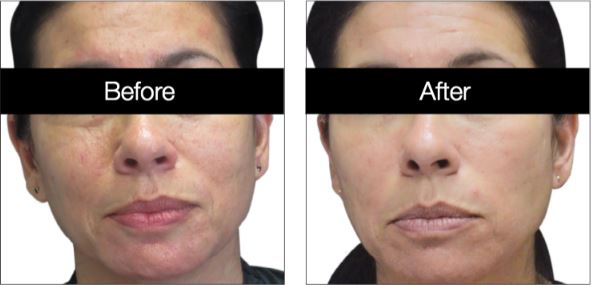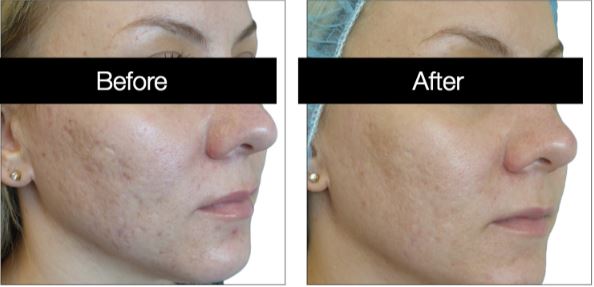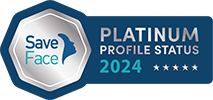Frequently Asked Questions
What Is Skin Resurfacing?
Skin resurfacing treatments improves the appearance of the skin. Problems such as acne marks or other scarring issues are reduced, uneven skin texture is improved, enlarged pores and wrinkles are minimised, and the appearance of stretch marks improved. It is also an effective anti-ageing treatment that reverses signs of skin damage from the sun and other environmental factors.
Skin resurfacing can be achieved through different technologies, including NanoFractional RF™ (Serenity’s treatment of choice), lasers and Intense Pulsed Light (IPL). Although IPL does not resurface the skin, it can improve the appearance of sun damage, red facial veins and hyperpigmentation.
To explain how we approach skin resurfacing at Serenity the following description of the different ways of achieving it may be useful:
Laser Skin Resurfacing
There are two basic types of laser:
What are known as ‘ablative lasers’ (such as carbon dioxide (CO2) or YAG lasers) resurface the skin by removing the outside layer of the skin, known as the epidermis, whilst heating the skin underneath, known as the dermis. The heat from the laser stimulates collagen production. Although this type of laser treatment can produce more dramatic results, it comes with an extended downtime of up to 3 weeks and with redness of the skin taking several months to fully settle down.
‘Non-ablative’ lasers do not remove the outer layer of skin and are therefore less invasive, while needing less downtime for the patients than ablative lasers. This technology also heats the skin in order to cause collagen production though it produces less dramatic results than with ablation.
You may also hear of the terms ‘fractional’ and ‘nonfractional’ in connection with skin re-surfacing. Fractional technology is the more recent of these two, and leaves untreated skin next to newly created microchannels. This allows for a faster recovery time and can reduce potential side effects.
However, laser technology is not the only way to achieve excellent results.
At Serenity we prefer to use a NanoFractional RF™ technique in which the skin resurfacing is achieved by using radio frequency energy. This combines ablation with coagulation. Ablation creates micro-channels in the skin that cause stimulation of the body’s natural healing process, while the accompanying coagulation promotes quick healing and leads to less downtime, while still triggering collagen remodelling. By using this technology, all skin types can be treated, which is not true of some laser skin resurfacing treatments.
What Makes Nanofractional Rf™ With Smartscan Different From Other Skin Resurfacing Treatments?
Using radio frequency energy, instead of the laser light options described above, NanoFractional RF™ with SmartScan™ delivers its treatment through a patented tip technology that contains individual pin sites. Through these pins the RF energy is delivered precisely so that it is distributed uniformly throughout the skin, with areas of skin tissue in between left intact to promote faster healing and low downtime. This process quickly draws reconstructive tissue to the treated areas, rebuilding collagen and in so doing leading to reduced skin damage.
Unlike traditional laser skin resurfacing technologies that are more at risk of causing post-inflammatory hyperpigmentation (PIH) - a condition where the skin is discoloured due to inflammation - NanoFractional RF™ with SmartScan™ is suitable for all skin types due to the highly controlled radio frequency energy source.
How Many Treatments Are Required?
For skin resurfacing treatments using NanoFractional RF™ with SmartScan™, 3 - 4 treatments are typically recommended every 4 - 6 weeks. Your practitioner will discuss this with you at your consultation.
Is There Any Downtime?
With NanoFractional RF™ skin resurfacing treatments there is minimal downtime of up to 3 days. Very small scabs that form 24 - 72 hours after your procedure will shed naturally. Makeup can be applied 24 hours after treatment.
Is Skin Resurfacing Treatment Painful?
You may experience the feeling of mild sunburn, which usually goes within 24 hours. There will be some swelling and redness after treatment but this generally subsides after 48 hours. Topical anaesthetic can be applied before treatment if required.
What Should / Shouldn’t I Do Before Treatment?
Please ensure you have discussed your medical history in full at your consultation. We need to know about any previous or current conditions, any previous or planned surgeries and any medications which have either been prescribed for you or bought over-the-counter. We also need to know about any other non-surgical treatments that you have had in the past. Please discuss these with us.
A patch test may be performed at your consultation or one will be arranged. This will be discussed with you.
What Should / Shouldn’t I Do After My Treatment?
After your procedure, your practitioner will explain your aftercare instructions in full. You will also be emailed a copy of these, along with a 24 hours emergency telephone number for any concerns you may have when you are at home.
To Remind You of Your Aftercare:
You will experience swelling of any wrinkles immediately after treatment. Swelling and redness of the full treated and untreated areas may occur after your procedure. This will be at its greatest 24 - 48 hours after. To minimise your swelling, Serenity advise that you keep your head elevated. There will be a sensation of heat as well as redness in the treated area, similar to mild sunburn. This may last for up to 24 hours. Tiny scabs will form 24 - 72 hours after your procedure and will remain for several days. Please do not touch or pick these scabs. They will fall off naturally. Do not apply any ice to the treatment area.
Makeup can be applied after 24 - 48 hours but please ensure that make up is thoroughly cleansed away before going to bed.
You may return to most normal activities immediately if you wish, but please avoid hot baths, saunas, steam rooms and swimming pools for at least the first 2 days after your treatment.
Please ensure that you use a sun screen of SPF 30 or greater after the skin has fully healed in 24 - 48 hours. This will be provided to you by your practitioner. We encourage the use of sun screens as a long term benefit to you.
What Areas Can Be Treated?
Areas that can be treated with NanoFractional RF™ skin resurfacing include both the face and the body, though there may be a longer downtime period required when areas are treated on the body.
Who Is Suitable for Skin Resurfacing Treatment?
NanoFractional RF™ with SmartScan™ skin resurfacing is suitable for all skin tones. There may however be other reasons why you are not suitable for treatment. These include, but are not limited to:
- having a pacemaker or defibrillator
- being pregnant, breastfeeding or having IVF treatment
- if you have or have a history of cancer
- having metal implants (excluding dental) in the treatment area
- having diseases in the treatment area that are triggered by heat: for example recurrent herpes in the treatment area; this will require pre-treatment.
- having a history of skin disorders and / or abnormal wound healing
- suffering from skin-related auto-immune diseases
- having taken Roaccutane in the past 6 months
- having an impaired immune system due to disease or medications
- Have had a face lift or eyelid surgery in the past year







